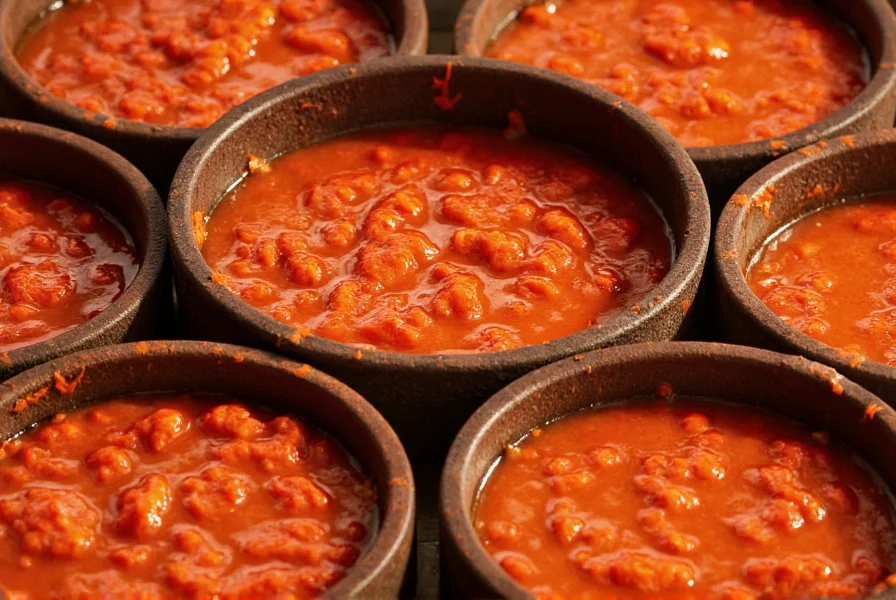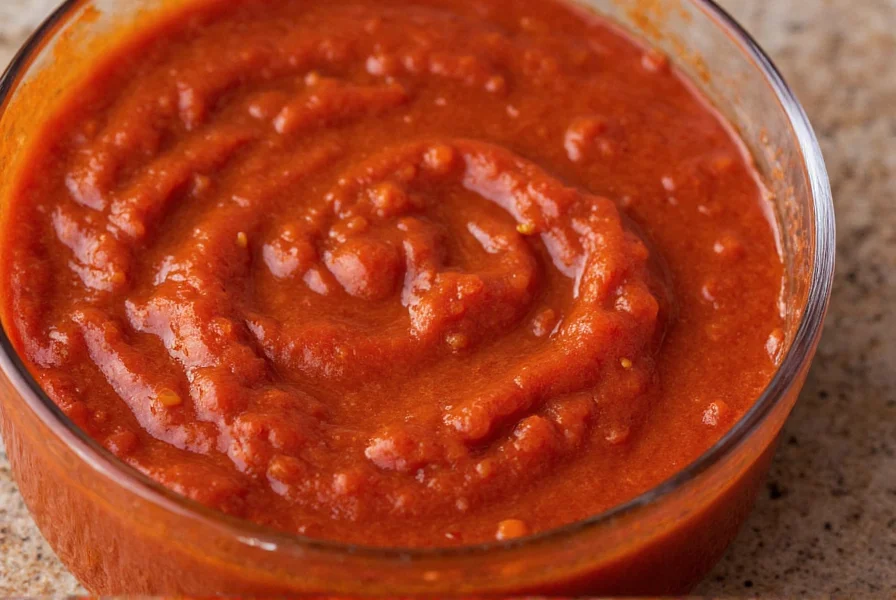Gochujang has evolved from a centuries-old Korean pantry staple to a globally celebrated ingredient, appearing in everything from gourmet restaurant menus to home kitchen cabinets. Understanding this vibrant red paste goes beyond simply recognizing it as ‘Korean hot sauce’—it represents a sophisticated fermentation tradition that creates unparalleled depth of flavor.
What Exactly Is Gochujang?
Unlike simple chili sauces, authentic gochujang undergoes a months-long fermentation process that develops its signature complexity. Traditional production begins with soaking glutinous rice, which is then steamed and mixed with powdered meju (fermented soybean blocks), red chili powder, and salt. This mixture matures in onggi (Korean earthenware pots) exposed to seasonal temperature variations, allowing natural fermentation to occur.
Modern commercial production maintains these core ingredients while adapting methods for consistency and shelf stability. The fermentation process creates enzymatic reactions that break down starches into sugars and proteins into amino acids, explaining gochujang’s distinctive sweet-umami balance despite containing no added sugar in traditional recipes.

Decoding Gochujang’s Flavor Profile
Gochujang delivers four distinct flavor dimensions that work in harmony:
- Spicy heat from Korean red chili peppers (gochugaru)
- Natural sweetness from enzymatic breakdown of rice starches
- Deep umami from fermented soybeans
- Earthy complexity from months of microbial activity
This multidimensional flavor profile makes gochujang functionally different from single-note hot sauces. While sriracha provides straightforward heat with garlic notes, and cayenne pepper offers pure capsaicin burn, gochujang contributes an entire flavor foundation to dishes. Professional chefs particularly value how its fermented components enhance mouthfeel and help other ingredients ‘pop’ without overwhelming them.
Gochujang vs. Similar Condiments: Key Differences
| Condiment | Base Ingredients | Texture | Flavor Profile | Best Culinary Uses |
|---|---|---|---|---|
| Gochujang | Chili powder, glutinous rice, fermented soybeans, salt | Thick paste | Spicy, sweet, umami, complex | Marinades, stews, dipping sauces |
| Gochugaru | Ground Korean chili peppers | Fine powder | Pure chili heat with fruitiness | Rubbing meats, kimchi making |
| Sambal Oelek | Chili peppers, vinegar, salt | Coarse liquid | Direct heat, acidic | Stir-fries, finishing sauce |
| Doubanjiang | Fermented broad beans, chili peppers | Chunky paste | Salty, funky, less sweet | Szechuan dishes, braises |
Practical Applications in Modern Cooking
Understanding how to use gochujang effectively transforms ordinary dishes. Unlike liquid hot sauces, its paste consistency allows it to cling to ingredients and caramelize beautifully when cooked. For authentic Korean applications, it forms the base of:
- Tteokbokki - Chewy rice cakes in spicy gochujang-based sauce
- Budae jjigae - ‘Army stew’ featuring gochujang broth
- Marinades for bulgogi - Combined with soy sauce and pear
- Bibimbap sauce - Mixed with sesame oil and vinegar
Global chefs have creatively adapted gochujang beyond traditional uses. Its balanced heat makes it ideal for:
- Glazing roasted vegetables (especially sweet potatoes and Brussels sprouts)
- Adding depth to barbecue sauces and burger spreads
- Enhancing salad dressings with umami complexity
- Creating unique cocktail ingredients (try a gochujang-infused bloody mary)

Storage Guidelines and Shelf Life
Proper storage maintains gochujang’s quality and safety. Unopened containers remain stable at room temperature until the printed expiration date, typically 1-2 years. After opening:
- Refrigerate immediately in an airtight container
- Use clean utensils to prevent contamination
- Expect 6-12 months of optimal quality in refrigerator
- Discard if mold appears, texture separates significantly, or develops off odors
The high salt content and fermentation process create a naturally preserved product, but refrigeration slows enzymatic activity that could eventually degrade flavor balance. Unlike many condiments, properly stored gochujang rarely ‘goes bad’ in the dangerous sense, but its flavor profile will gradually diminish over time.
Finding Suitable Substitutes
When authentic gochujang isn’t available, understanding what aspect you need to replicate determines the best alternative:
- For heat and color only: Mix 1 tbsp tomato paste + 1 tsp cayenne pepper
- For texture and moderate heat: Combine 2 tbsp harissa + 1 tsp honey
- For umami depth: Blend 1 tbsp miso paste + 1 tsp smoked paprika
- Closest overall substitute: 1.5 tbsp doenjang (Korean soybean paste) + 1 tbsp gochugaru + 1 tsp sugar
These alternatives work in a pinch but cannot replicate gochujang’s unique fermented complexity. Serious Korean cooking enthusiasts should consider making small batches at home using traditional methods for truly authentic results.
Selecting Quality Gochujang
When purchasing gochujang, check ingredient labels for these markers of quality:
- First ingredients should be gochugaru (red pepper powder), glutinous rice, and meju powder
- Avoid products listing corn syrup or artificial sweeteners as primary ingredients
- Traditional varieties contain no vinegar (a modern preservation technique)
- Higher-end products specify fermentation duration (60+ days indicates traditional methods)
Color provides immediate quality indication—authentic gochujang displays a deep, vibrant red without artificial orange hues. Texture should be smooth yet substantial, spreading easily without being watery. The most reliable brands maintain consistency across batches while allowing subtle seasonal variations reflecting traditional production methods.
Frequently Asked Questions
Is gochujang the same as sriracha?
No, gochujang and sriracha differ significantly. Gochujang is a thick, fermented Korean paste made from chili powder, glutinous rice, and soybeans, offering complex sweet-umami-spicy notes. Sriracha is a Vietnamese-inspired Thai chili sauce made primarily from chili peppers, vinegar, and garlic, with a thinner consistency and sharper, more acidic heat profile. They serve different culinary purposes and aren't direct substitutes.
Can I make gochujang at home?
Yes, but traditional homemade gochujang requires significant time and specific ingredients. Authentic preparation involves fermenting a mixture of glutinous rice, meju powder (fermented soybean blocks), gochugaru (Korean chili powder), and salt for 60-180 days in earthenware pots. Modern simplified versions use miso paste as a fermentation starter but won't achieve the same depth as traditionally made gochujang. Home production requires careful attention to sanitation to prevent harmful bacterial growth during fermentation.
Why does gochujang taste sweet if it contains no sugar?
Gochujang's natural sweetness comes from enzymatic breakdown of starches during fermentation. The glutinous rice provides complex carbohydrates that enzymes from the fermentation process convert into simple sugars. Traditional gochujang contains no added sugar—the sweetness develops naturally over the fermentation period, creating a balanced flavor profile where the heat of the chilies harmonizes with this inherent sweetness.
Is gochujang gluten-free?
Authentic traditional gochujang is naturally gluten-free as it uses glutinous rice (which is gluten-free despite its name) rather than wheat. However, some commercial varieties may contain wheat-based ingredients or be processed in facilities with gluten-containing products. Always check labels if you require strict gluten-free products, as manufacturing practices vary between brands. Korean-certified products with the ‘HACCP’ mark generally provide reliable gluten-free options.
How spicy is gochujang compared to other chili products?
Gochujang typically measures 1,500-2,500 on the Scoville scale, making it moderately spicy—less intense than cayenne pepper (30,000-50,000 SHU) but spicier than paprika (100-500 SHU). Its heat is balanced by natural sweetness and umami, creating a more complex sensation than single-note hot sauces. The fermentation process also modifies capsaicin compounds, resulting in a slower-building, more rounded heat that integrates well with other flavors rather than overwhelming them.











 浙公网安备
33010002000092号
浙公网安备
33010002000092号 浙B2-20120091-4
浙B2-20120091-4